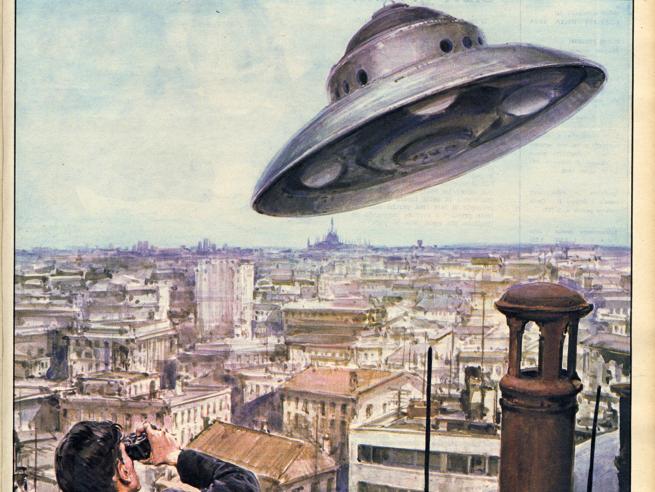– de Salvatore Serra –
Su traballu terminològicu est fundamentale in sa polìtica linguìstica de sas limbas minorizadas, ca servit a bìnchere sa diglossia.
Operende in custu setore, tocat a cunfrontare sa limba interessada cun sas àteras limbas.
Inoghe, a ghisa de mustra, bos propòngio unas cantas frases in inglesu dae su giassu https://www.bbc.com/culture/article/20220714-the-ufo-sightings-that-swept-the-us cun sa tradutzione in sardu.
………………………………………………..
Seventy-five years on from the first mysterious sightings in the US, the flying saucer makes its return in Jordan Peele’s new film Nope. Nicholas Barber looks back at one of the most haunting objects in popular culture.
- Setantachimbe annos a pustis de sos primos avistamentos misteriosos in sos Istados Unidos, sos discos chi bolant torrant in sa pellìcula noa de Jordan Peele, “Nope”. Nicholas Barber nos faghet su contu de unu de sos ogetos prus persighidores de sa cultura populare.
It’s only there for a moment in the trailer for Jordan Peele’s new horror film, Nope, but it’s definitely there: a flying saucer. Judging by the twists and turns in Peele’s previous films, Get Out and Us, it’s impossible to say whether its real or fake, whether it’s from the Earth or from outer space, but that glimpse of sparkling silver is tantalising. Maybe, just maybe, Nope will be a proper flying-saucer movie – a celebration of one of the most recognisable and spine-tingling shapes in the history of popular culture.
- B’est sceti pro un’iscuta in su trailer de sa pellìcula orrorìfica noa de Jordan Peele, “Nope”, ma b’est: unu discu chi bolat. Pensende a sos corfos de iscena in sas àteras pellìculas de Peele, “Get Out” e “Us”, est impossìbile a nàrrere si est reale o si est farsu, si benit dae sa Terra o dae s’ispàtziu, ma cussu lampu de prata lugorosa nos ponet in birbìlliu. Forsis, sceti forsis, “Nope” at a èssere pròpiu una pellìcula subra de sos discos chi bolant – una tzelebratzione de una de sas formas prus reconnoschìbiles e prus artzuddadoras in s’istòria de sa cultura populare.
“By the end of the 1950s,” says Andrew Shail, senior lecturer in film at Newcastle University, “that particular shape had become a shorthand for ‘spacecraft piloted by beings from another world’, available to everyone working in the visual arts.” Sure enough, flying saucers have signified mysterious visitors from Mars and beyond in countless films, TV series, novels, comics, and even hit records, from Mulder’s I Want To Believe poster in The X-Files TV series to the popular children’s picture book, Aliens Love Underpants. The flying saucer is a design classic – the archetypal Unidentified Flying Object. And yet it didn’t take off, so to speak, until the 1950s, when the world went flying-saucer crazy.
- “Dae s’agabbu de sos annos 50”, narat Andrew Shail, professore titulare de tzinematografia in s’Universidade de Newcastle, “cussa forma particulare est devènnida un‘abreviadura pro ‘astronave ghiada dae èsseres de un’àteru mundu’, disponìbile pro chie si siat chi traballet in sas artes visuales ”. De seguru sos discos chi bolant ant chertu nàrrere visitadores misteriosos dae Marte e dae logos prus a tesu in unu muntone de pellìculas, sèries televisivas, romanzos, fumetos, e finas cantzones famadas, dae su poster “I Want To Believe” de Mulder in sa sèrie televisiva “The X-Files” a su libru illustradu populare pro pitzinnos “Aliens Love Underpants”. Su discu chi bolat est unu clàssicu de su disinnu: s’ “Ogetu chi bolat no identificadu” archetìpicu. E belle gasi no at decolladu, pro la nàrrere gasi, finas a sos annos 50, cando su mundu s’est ammachiadu pro sos discos chi bolant.
Science-fiction artists had drawn circular spacecraft long before that: an early Flash Gordon strip from 1934 features a spinning “squadron of deadly space-gyros”. But if you flick through copies of Startling Stories, Super Science Stories and other pulp magazines of the period, you’ll see that in the first half of the 20th Century, aliens preferred their transport to resemble submarines and airships.
- Sos artistas de fantasièntzia aiant disinnadu astronaves tundas meda in antis: unos de sos primos fumetos de Flash Gordon in su 1934 rapresentat unu “ iscuadrone de giroscòpios ispatziales letales ” chi girat a fùrriu de sesi. Ma si isfogiades còpias de “Startling Stories”, “Super Science Stories” e àteras revistas “pulp” de su tempus, ais a bìdere chi in su primu mesu de su sèculu XX sos alienos preferiant chi sos mèdios issoro de trasportu esserent partos sutamarinos e dirigìbiles.


